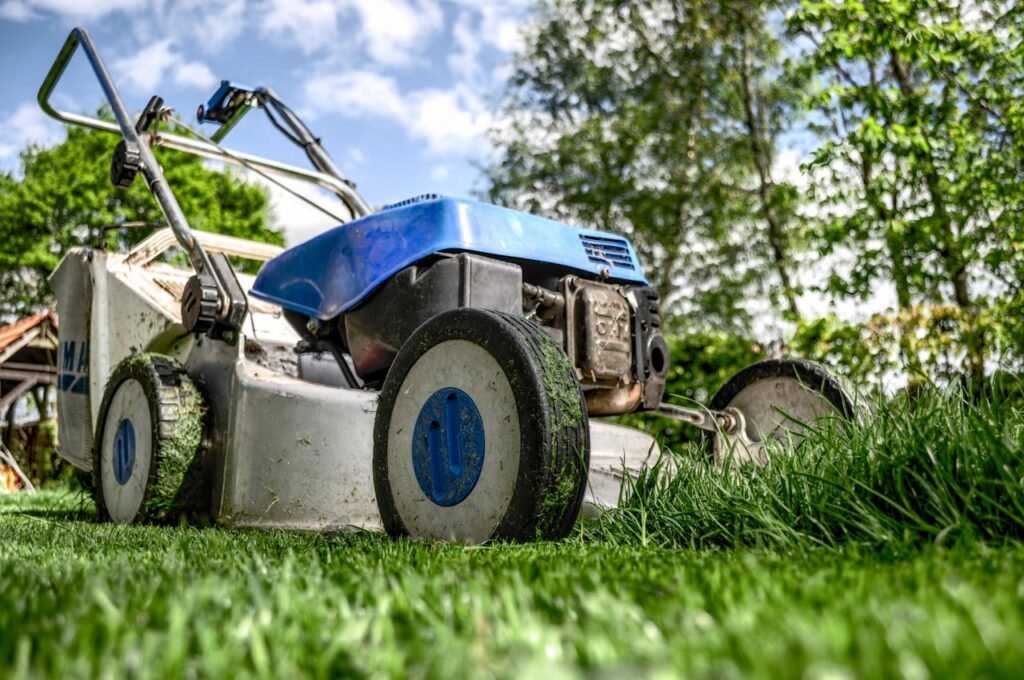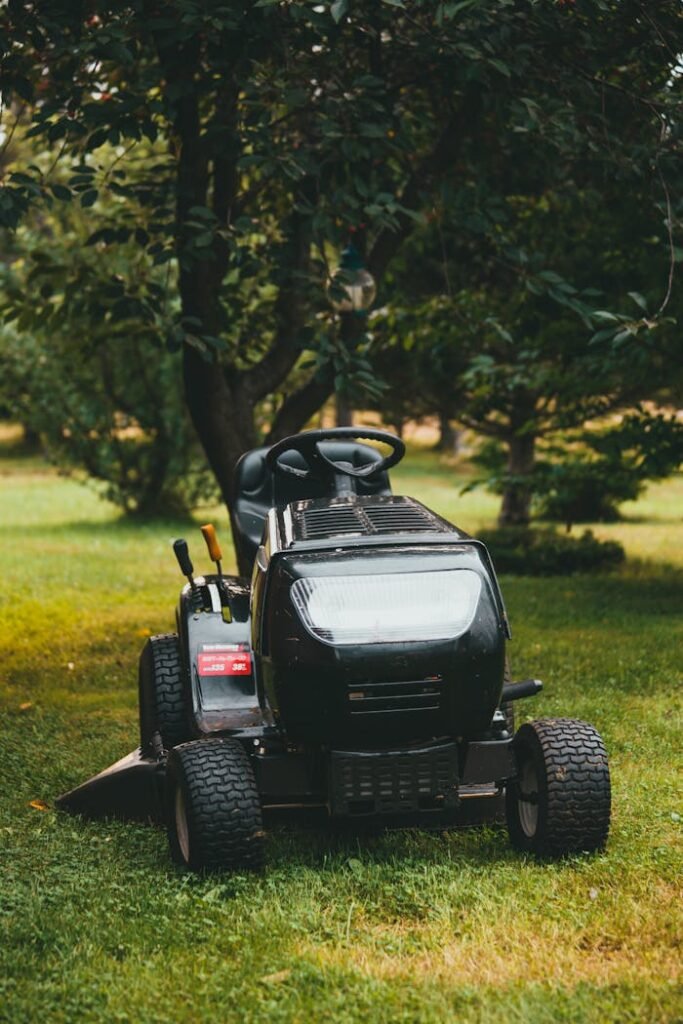Introduction to Lawn Mowers
Lawn mowers have become indispensable tools for maintaining a well-kept lawn, providing both aesthetic appeal and functional benefits.
The history of lawn mowers dates back to the early 19th century when Edwin Budding invented the first mechanical mower in 1830. This innovation revolutionized garden maintenance, offering a more efficient method compared to the labor-intensive scythe.
Over the years, lawn mowers have undergone significant evolution, adapting to the changing needs of homeowners and advancements in technology.

From the basic push mowers of the past to today’s sophisticated electric and gas-powered models, the development of lawn mowers reflects a continuous quest for efficiency and ease of use. Modern lawn mowers now offer a range of features, from self-propelling mechanisms to automated robotic systems, catering to various lawn sizes and user preferences.
Choosing the right lawn mower is crucial for maintaining the health and appearance of your lawn.
The right mower can make the difference between a laborious chore and a manageable task, especially when considering the diverse requirements of small versus large yards. Factors such as the type of terrain, grass variety, and personal physical capability play significant roles in determining the most suitable lawn mower.
In essence, understanding the evolution and importance of lawn mowers sets the stage for making an informed purchase. Whether you are a seasoned gardener or a new homeowner, selecting the appropriate lawn mower will ensure your lawn remains pristine and well-maintained throughout the seasons. This guide aims to provide comprehensive insights to help you make the best choice for your lawn care needs.
Types of Lawn Mowers
Lawn mowers come in various types, each designed to cater to different lawn sizes, terrains, and user preferences. Understanding these options is crucial for making an informed purchase. Here, we delve into the most common types of lawn mowers: push mowers, self-propelled mowers, riding mowers, and robotic mowers.
Push Mowers
Push mowers are manual devices that require the user to exert physical effort to move them forward. They are ideal for small to medium-sized lawns with flat terrain. The primary advantage of push mowers is their simplicity and low maintenance. They are also environmentally friendly, as they do not consume fuel or electricity. However, their reliance on human power can be a drawback for larger lawns or hilly areas.

Self-Propelled Mowers
Self-propelled mowers are a step up from push mowers. They come equipped with a transmission that drives the wheels, reducing the physical effort required by the user. These mowers are suitable for medium to large lawns and can handle uneven terrains more effectively. While they offer convenience and efficiency, they tend to be more expensive and require regular maintenance.
Riding Mowers
Riding mowers are designed for extensive lawns and are particularly useful for properties over half an acre. These mowers allow the user to sit and steer, making them highly efficient for large-scale mowing tasks. The significant benefits include speed, comfort, and the ability to cover large areas quickly. However, they come with a higher price tag and require ample storage space. Additionally, their maintenance can be more complex compared to smaller mowers.

Robotic Mowers
Robotic mowers represent the cutting edge of lawn care technology. These autonomous devices can mow your lawn with minimal human intervention. They are perfect for tech-savvy homeowners who prefer a hands-off approach to lawn maintenance. Robotic mowers are energy-efficient and can be programmed to operate at specific times. However, their initial cost is high, and they may struggle with very large or highly complex lawns.
By understanding the different types of lawn mowers, you can better assess which one aligns with your specific needs, ensuring a well-maintained lawn with minimal hassle.
Electric vs. Gas Lawn Mowers
When considering a lawn mower purchase, one of the fundamental decisions is choosing between electric and gas-powered models. Each type has unique advantages and drawbacks, making the choice dependent on factors such as yard size, environmental concerns, and personal preferences.
Electric lawn mowers, which can be either battery-operated or corded, are known for their eco-friendliness and lower maintenance. Battery-operated electric mowers offer the convenience of mobility without the need for an extension cord, although they are typically suitable for smaller lawns due to battery life limitations. Corded electric mowers, while reliable for uninterrupted mowing, restrict movement and require proximity to a power outlet. Both types are generally quieter than gas models, produce no direct emissions, and start effortlessly with the push of a button.
In contrast, gas lawn mowers are renowned for their power and performance, particularly for larger lawns and tougher mowing conditions. Equipped with various types of engines, such as two-stroke or four-stroke, gas mowers can handle thick grass, uneven terrain, and extensive areas without the need for recharging or external power sources. However, they come with several caveats: regular maintenance is essential to keep the engine in optimal condition, including oil changes, air filter replacements, and spark plug checks. Additionally, gas mowers are louder, produce emissions, and require fuel storage and handling.
From a cost perspective, electric mowers generally have a higher upfront price but lower ongoing costs due to minimal maintenance and the absence of fuel expenses. Gas mowers, while potentially cheaper initially, incur higher long-term costs as a result of fuel, oil, and frequent maintenance requirements.
Environmental impact is another critical factor. Electric mowers are the more sustainable option, with reduced carbon footprint and absence of harmful emissions. Gas mowers, on the other hand, contribute to air pollution and require fossil fuels, posing a negative environmental impact.
Ultimately, the decision between electric and gas lawn mowers hinges on individual needs and priorities. For eco-conscious consumers with small to medium-sized lawns, electric mowers present a compelling option. Conversely, those with larger properties or demanding mowing conditions may find gas mowers to be more efficient and reliable.
Key Features to Look For
When purchasing a lawn mower, it is crucial to consider several key features to ensure you select the right model for your needs. One of the primary aspects to examine is the cutting width. The cutting width determines how much grass the mower can cut in a single pass. A wider cutting width can reduce the time spent on mowing, particularly for larger lawns. However, for smaller or more intricate yards, a narrower cutting width may provide better maneuverability.
Another important feature is the height adjustment capability. This allows you to modify the cutting height of the mower blades, which is essential for maintaining different types of grass and achieving the desired lawn appearance. Mowers with multiple height settings provide greater flexibility and are ideal for accommodating seasonal changes in grass growth.
Engine power is a critical factor that influences the mower’s performance. More powerful engines can handle thicker and taller grass with greater ease, making them suitable for larger and more demanding lawns. Conversely, smaller engines may be adequate for smaller yards but may struggle with tougher terrain or dense grass.
Ease of starting is another key consideration. Traditional pull-start mowers can be challenging for some users, while models with electric start options offer greater convenience and ease of use. This feature is particularly important for those who may have physical limitations or prefer a hassle-free start-up process.
Maneuverability plays a significant role in the overall mowing experience. Consider the mower’s weight, wheel size, and design when evaluating its maneuverability. Lighter mowers with large, sturdy wheels are easier to navigate around obstacles and through tight spaces.
Durability is a critical aspect to ensure the longevity of your investment. Look for mowers constructed with high-quality materials and robust build quality. This will help withstand regular use and exposure to outdoor elements, preventing frequent repairs or replacements.
Finally, safety features should not be overlooked. Features such as blade brakes, automatic shut-off mechanisms, and sturdy guards are essential for preventing accidents and ensuring safe operation. Prioritizing these safety features will provide peace of mind while using your lawn mower.
By carefully considering these key features—cutting width, height adjustments, engine power, ease of starting, maneuverability, durability, and safety features—you can make an informed decision and select a lawn mower that meets your specific needs and enhances your lawn care routine.
Budget Considerations
When selecting a lawn mower, understanding your budget is crucial. Lawn mowers come in a wide range of prices, and what you can expect in terms of features and performance varies significantly across different price points. Typically, entry-level lawn mowers can be found in the $100 to $300 range. These models are generally suitable for small to medium-sized lawns and provide basic cutting functionalities. However, they may lack advanced features such as self-propulsion, mulching capabilities, or multiple speed settings.
Mid-range lawn mowers, priced between $300 and $600, often offer a better balance of performance and additional features. These models usually include enhancements like variable speed control, larger cutting decks, and improved durability. If your lawn is larger or has varied terrain, investing in a mid-range mower can improve efficiency and ease of use. Moreover, these mowers tend to have a longer lifespan when properly maintained, making them a more cost-effective option in the long run.
Premium lawn mowers, which start at around $600 and can go up to several thousand dollars, provide top-tier performance and an array of advanced features. High-end models may include zero-turn capabilities, electric start, powerful engines, and superior build quality. For extensive lawns or commercial use, these mowers offer unmatched efficiency and durability. While the initial investment is higher, the reduced maintenance costs and extended longevity can justify the expense over time.
Financing options are available for those looking to spread the cost of a more expensive lawn mower. Many retailers offer installment plans or special financing deals, particularly during peak gardening seasons or holiday sales. Additionally, keeping an eye out for deals, discounts, and manufacturer rebates can also help in securing a high-quality lawn mower within your budget.
Ultimately, determining the best value for your money involves balancing initial costs with long-term advantages. Assessing your lawn’s specific needs and considering the mower’s durability, maintenance requirements, and potential financing options will guide you towards the most suitable purchase.
Maintenance and Care
Proper maintenance is crucial for the longevity and performance of a lawn mower. Regular upkeep not only ensures that your lawn mower runs efficiently but also extends its lifespan, saving you from frequent and costly replacements. One of the most fundamental tasks in lawn mower maintenance is blade sharpening. Dull blades can tear grass rather than cut it cleanly, leading to an uneven lawn and increased stress on the mower’s engine. It’s recommended to sharpen the blades at least once a season or after every 20-25 hours of use.
Another critical aspect of lawn mower maintenance is performing regular oil changes. Much like a car engine, a lawn mower’s engine relies on clean oil to function smoothly.
Over time, oil can become contaminated with dirt and debris, leading to decreased performance and potential engine damage. Check the manufacturer’s recommendations for the type and frequency of oil changes, but a good rule of thumb is to change the oil every 50 hours of operation or at the start of each mowing season.
Air filter replacement is another essential maintenance task. A clean air filter ensures that your lawn mower’s engine receives the proper air-fuel mixture, which is vital for efficient combustion. A clogged or dirty air filter can lead to poor engine performance and increased fuel consumption. Inspect the air filter regularly and replace it as needed, typically once a season or more frequently if you mow in dusty conditions.
Proper storage of your lawn mower, especially during the off-season, is also vital.
Store the mower in a dry, sheltered area to protect it from the elements. Before storing, clean the mower thoroughly, remove any grass clippings and debris, and drain the fuel tank to prevent fuel degradation and carburetor issues.
Despite regular maintenance, lawn mowers can still encounter issues. Common problems include difficulty starting, uneven cutting, or unusual noises. Troubleshooting these issues can often be done at home by checking the spark plug, fuel levels, and blade condition. However, for more complex problems, seeking professional repair services is advisable to avoid further damage.
Environmental Considerations
When selecting a lawn mower, understanding the environmental impact is crucial. Among the most significant factors to consider are the differences between electric and gas-powered models.
Gas-powered lawn mowers, while powerful, emit a considerable amount of pollutants. According to the Environmental Protection Agency (EPA), a gas-powered mower can produce as much pollution in an hour as 11 cars. These emissions contribute to air pollution and negatively impact air quality.
In contrast, electric lawn mowers are a more eco-friendly option. They produce no direct emissions, making them a preferable choice for reducing your carbon footprint. Advances in battery technology have made electric mowers more efficient and capable of handling larger lawns, making them a viable alternative to their gas-powered counterparts.
Noise pollution is another consideration. Gas-powered mowers are notoriously loud, contributing to noise pollution that can affect not just your household but your entire neighborhood. Electric mowers, on the other hand, operate much more quietly, providing a more peaceful mowing experience.
Eco-friendly lawn mowers also offer benefits beyond reduced emissions and noise levels. Many electric models are also designed with energy efficiency in mind, minimizing energy consumption.
Additionally, some electric mowers feature mulching capabilities that recycle grass clippings back into the lawn, providing natural fertilization and reducing waste.
For those committed to environmentally conscious lawn care, there are several tips to follow. First, consider mowing your lawn less frequently. Allowing the grass to grow a bit longer can promote root development and reduce the need for watering.
Second, avoid mowing during the hottest part of the day to conserve energy and reduce stress on the grass. Finally, regularly maintain your mower to ensure it operates efficiently, whether it is gas or electric.
By carefully considering the environmental impact of your lawn mower choice and adopting eco-friendly mowing practices, you can enjoy a well-maintained lawn without compromising the health of our planet.
Making the Final Decision
As we reach the end of our comprehensive guide, it’s time to summarize the critical points that will assist you in making an informed lawn mower purchase. By now, you should have a clear understanding of the different types of lawn mowers, their features, and their suitability for various lawn sizes and terrains. Here’s a step-by-step checklist to help you finalize your decision:
1. Determine Your Lawn Size and Type: Assess the size of your lawn and its specific requirements. Smaller lawns may benefit from manual or electric mowers, while larger areas might require a gas-powered or riding mower.
2. Consider the Terrain: If your lawn has slopes or uneven ground, opt for a mower with better maneuverability and stability, such as self-propelled models.
3. Evaluate the Power Source: Decide between electric, battery-powered, or gas mowers based on your preferences for maintenance, environmental impact, and convenience.
4. Check Features and Accessories: Look for essential features like adjustable cutting heights, easy-start mechanisms, and mulching capabilities. Accessories such as baggers or weed whackers can also enhance your lawn care routine.
5. Set a Budget: Establish a budget that aligns with your needs and stick to it. Remember that investing in a quality mower can save you money in the long term.
Once you have ticked off these steps, the next phase is deciding where to make your purchase. Both online and in-store options come with their pros and cons. Shopping online can offer a broader selection, competitive prices, and the convenience of home delivery. However, purchasing from a physical store allows you to inspect the mower firsthand and seek professional advice from sales representatives.
Reading reviews and seeking recommendations from friends, family, or online forums can also provide invaluable insights. Pay attention to both positive and negative feedback to get a balanced view of the product’s performance and reliability.
Equipped with this detailed guide, you are now ready to confidently choose the right lawn mower that meets your specific needs and preferences. Happy mowing!


